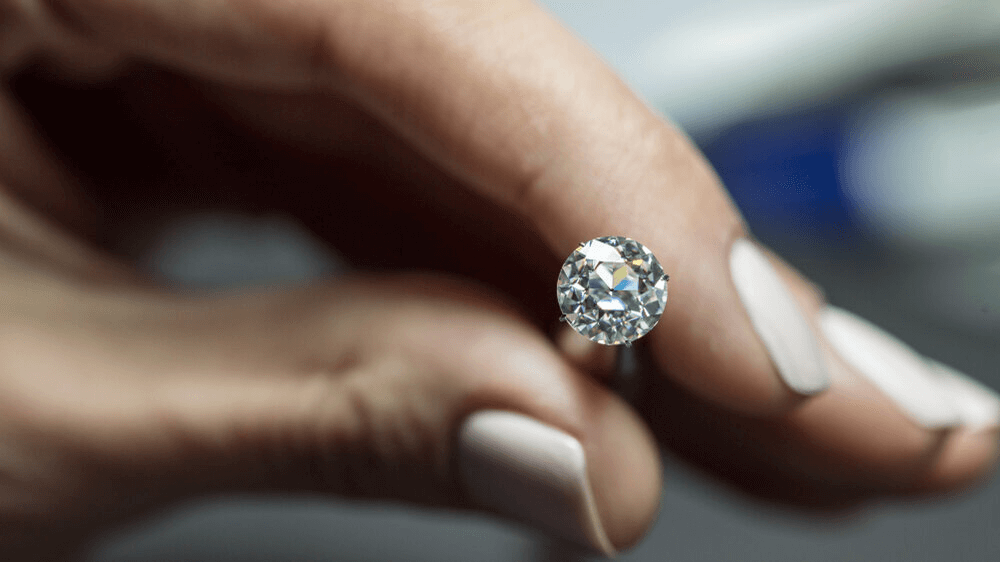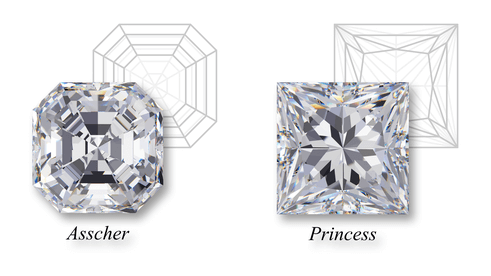Why Emerald Cut Diamonds Reign Supreme

By Gary A.

Edited by Olivia H.
Published Jul 12, 2022
Edited on Mar 31, 2025
With its timeless elegance and distinctive shape, an emerald cut diamond offers a sophisticated choice for those seeking a unique yet classic engagement ring.

Navigate This Guide:
- 7 Quick Tips for Buying an Emerald Cut Diamond Engagement Ring
- Introduction to Emerald Cut Diamonds
- Definition and Unique Features
- The Historical Significance of the Emerald Cut
- The Pros and Cons of the Emerald Cut
- Technical Insights: Ratio, Clarity, and Color
- Choosing the Right Clarity Grade for Emerald Diamonds
- Emerald Cut vs Other Shapes
- Our Expert Take
- 10 FAQs
Before we dive deeper into the specifics, here are some practical tips to help guide your decision-making process:
7 Quick Tips for Buying an Emerald Cut Diamond Engagement Ring
When selecting an emerald cut diamond for an engagement ring, it’s crucial to pay attention to several specific factors. These considerations will ensure you choose a diamond that not only looks beautiful but also offers the best value and quality for your investment.
- Tip 1: Assess the Length-to-Width Ratio: The length-to-width ratio of an emerald cut diamond significantly affects its overall appearance. A classic emerald cut typically has a ratio between 1.30 and 1.60. Tip: Decide on the desired shape – more elongated or closer to square – and choose a ratio that matches this preference.
- Tip 2: Prioritize Clarity: Emerald cut diamonds have large, open tables which make inclusions more visible. They don’t hide flaws as well as other cuts. Tip: Look for diamonds with a higher clarity grade (VS1 or VS2) to ensure fewer visible inclusions.
- Tip 3: Understand the Impact of Color: Color can appear more pronounced in emerald cut diamonds due to their large, open facets. Tip: Opt for a higher color grade if budget allows. G-H color grade can offer a good balance between quality and cost.
- Tip 4: Examine the Cut Quality: The quality of the cut determines how well the diamond interacts with light, affecting its brilliance and overall appeal. Tip: Seek emerald cut diamonds with good or excellent polish and symmetry ratings to ensure a lively and bright appearance.
- Tip 5: Consider the Setting Style: The ring setting can enhance the diamond’s beauty and provide protection to the stone. Tip: A sturdy setting like a four-prong or bezel can secure the diamond well. For added sparkle, consider halo or side-stone settings.
- Tip 6: Be Mindful of Proportions: Proportions in an emerald cut diamond affect its balance and appeal. Tip: Look for a well-proportioned diamond where the depth and table percentages are within ideal ranges to maximize the stone’s elegance.
- Tip 7: Check for Bow-Tie Effect: Some emerald cut diamonds can exhibit a visible bow-tie effect, a dark area across the center that can detract from the stone’s beauty. Tip: Visually inspect the diamond under different lighting conditions to ensure minimal or no bow-tie effect.
Now that you’ve got these practical tips, use Jeweler AI below to find the perfect engagement ring that suits your style and budget:
Introduction to Emerald Cut Diamonds
Like the Round Brilliant, the Emerald cut enjoys steady, timeless popularity for engagement rings. True, the two cuts represent the polar opposites of one another – and the Emerald is by no means as popular as the Round – but, in this one respect, they are equal.
This is, of course, because of the fact that the Emerald possesses a refined elegance in a unique way that it catches the light and the fascinating ‘hall of mirrors’ effect enjoyed by anyone who gets the chance to look deep into its glassy depths. Its linear shape gives it an air of classic glamour and the Art Deco styles of ‘Old Hollywood’ – something that gives it an undeniable appeal, even among those who initially thought they wanted more sparkle than the Emerald can offer.
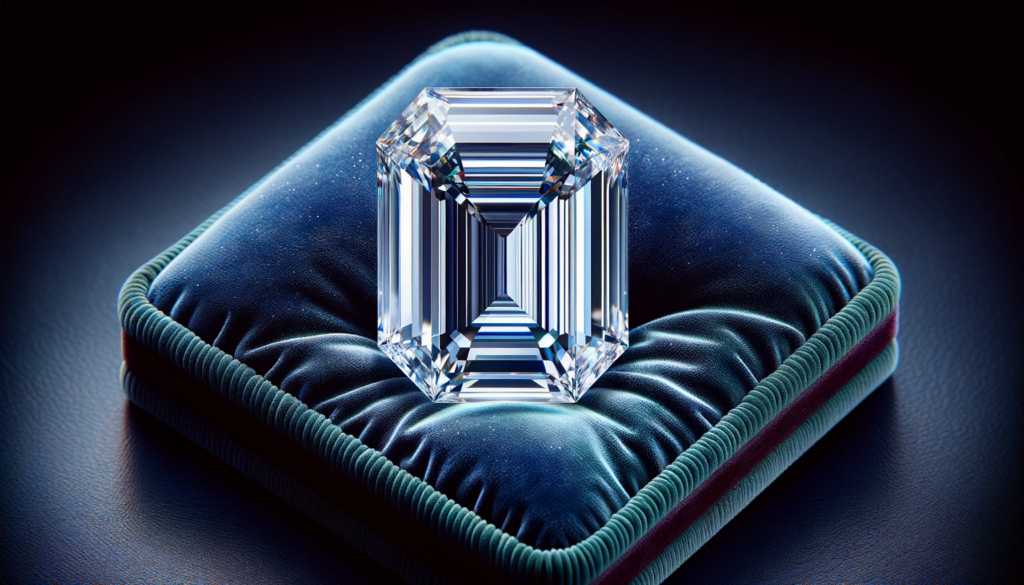
Definition and Unique Features
The Emerald cut is a rectangular-shaped cut with truncated corners and a broad, flat plane that resembles a staircase when viewed from above.
It is created by the step cuts of its pavilion and its large, open table, producing a hall-of-mirrors effect. The Emerald cut usually comprises 57 facets – 25 on the crown and 32 on the pavilion – although the number of rows can vary. The Emerald cut was designed to showcase the diamond’s clarity, instead of its fire, since it offers a clear, glassy view into the diamond’s interior.
As a result, the cut is commonly used to exhibit the incredible clarity of the stone, and to create a seemingly endless labyrinth of angles and steps.
It is striking enough to be worn with very little decoration – as in this classic Emerald Cathedral Engagement Ring – although many choose to complement the refined shine of the cut with the brilliant sparkle of a pavé, as in this Emerald Cut Pavé Ring.
The Historical Significance of the Emerald Cut
The exact history of the emerald cut isn’t known, but it can be traced back about 500 years to the multi-faceted table cuts of the Art Deco period in the early 20th century. As its name suggests, it was named after the original purpose of the cut – the cutting of emeralds – when diamond cutters realized the importance of the cut and begin applying it to diamonds as well.
Under the light, this cut shines and flashes in a way that is totally different to the super brilliant and fiery Round cut – and, of course, the modified brilliant cuts. The unique angles of the Emerald celebrate a different side to the diamond, and give us a clearer view into the very heart of the stone.
Over the years, it has been favored by many – although most notably by Princess Grace Kelly of Monaco, who was, at the time, still lighting up the silver screen as one of Hollywood’s biggest stars. Her ring, which featured a 10.47 carat Emerald, made a sparkling appearance in her final film – High Society – and immortalized the appeal of the cut.
Since then, many celebrities have worn the gorgeous Emerald cut, such as Mariah Carey, Angelina Jolie, and Beyoncé, and it’s not difficult to see why. With only 3% of the world’s diamonds cut in the Emerald shape, this unique cut brings with it status and exclusivity.
The Pros and Cons of the Emerald Cut
There are a few pros and cons to consider with the Emerald cut.
The Pros
The first pro is that Emerald cuts look larger. Because of its step-cuts, an emerald cut has a 5% greater surface than other diamond cuts, making it look larger. As a result, you can channel more money into other features, such as clarity and color, without having to worry about getting the biggest carat weight possible at your price point.
Obviously, cost is another great benefit. You can purchase an Emerald diamond that looks larger for a lower price. Also, because Emerald cut diamonds are elongated, they give the illusion of longer and more slender fingers, making them a highly flattering choice.
The Cons
A con of the Emerald cut has to do with its sparkle. The Emerald cut doesn’t have a lot of flash and fire, so if that’s what you’re looking for – or if you think your future bride is has her heart set on a sparkly center stone – then you might want to choose a different cut.
Of course, you can improve the overall sparkle of a ring with a halo, pavé or side stone featuring a more brilliant cut but, even so, many people still favor the light performances of other cuts.
Also, remember that clarity matters even more when it comes to the Emerald. The many small, sparkling facets of the Round and Fancy cuts mean that minor inclusions are much harder to spot. Looking into an Emerald cut diamond is like looking into a clear pool of water, where every small detail is very, very obvious.
Emerald Cuts and Light Performance (Sparkle)
While the Round Brilliant emits countless flashes of fire and brilliance, the Emerald cut shines in a more subdued way – although the effect is no less beauty.
This gentler shine is how we are able to see deep into the stone, and to appreciate that characteristic hall of mirrors effect.
If you’re drawn in by the basic shape of the Emerald, but still want a little more sparkle, then finding out more about the Radiant cut could be a great place to start. This shape marries together the best of both worlds in terms of geometry and sparkle, creating something even more unique – and highly modern in appearance.
Diamonds with a high clarity grade are accompanied by a premium value, and there is undoubtedly an element of high status attached to the large, clear Emeralds that have been photographed on celebrities’ fingers. But, more so than that, there is a certain old-world glamour to this cut, and it’s no surprise that Hollywood’s 21st century starlets are still so fond of its significance.
Emerald Diamonds and Size
Yes, the larger table on the Emerald cut – and its elongated shape – can make it appear larger than other diamonds.
This is often seen as a great selling point for the Emerald, as it is for other elongated shapes like the Oval, Pear and the Marquise cut. What this means is that, for a lower cost, buyers are able to create the illusion of a stone with a much higher carat weight – particularly when it is compared directly alongside diamonds that carry more weight in their pavilion than their crown.
Technical Insights: Ratio, Clarity, and Color
There are a few things to consider when choosing an Emerald cut:
First of all, the length-to-width ratio is very important. Choosing an Emerald cut with the proper ratio is key to finding exactly what you want. A classic cut has a LW ratio of around 1.50.
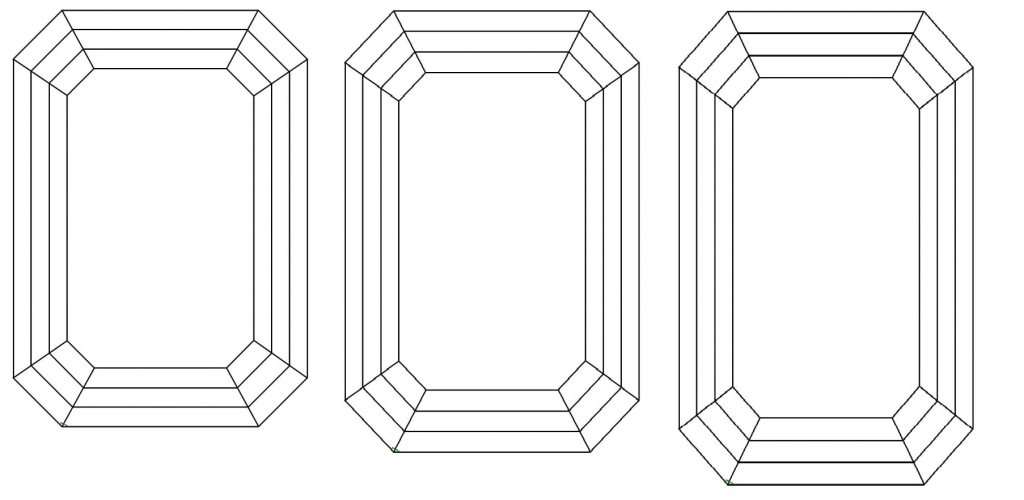
Secondly, evaluating color is subjective. Many Emerald buyers prefer warmer colors of a G – H diamond over the colorlessness of a D – F diamond, but the truth is that everyone has their own color preference.
The following cut, color and clarity guides should be taken into consideration when choosing an Emerald cut diamond:
Emerald Cut Diamond Cut Guide
The cut attributes of a diamond contribute to its sparkle, brilliance, and bling. Most knowledgeable buyers would choose attributes from the Excellent – Very Good columns.
| Excellent | Very Good | Good | Fair | Poor | |
| Table % | 60 – 65.9 | 58 – 59.9 or 66 – 72.9 | 54 – 57.9 or 73 – 74.9 | 51 – 53.9 or 75 – 79.9 | <50.9or>80 |
| Depth % | 63 – 67.9 | 59 – 62.9 or 68 – 69.9 | 57 – 58.9 or 70 – 74.9 | 54 – 56.9 or 75 – 79.9 | <53.9or>80 |
| Girdle | Very Thin to Slightly Thick | Very Thin or Thick | Very Thin or Very Thick | Extremely Thin or Extremely Thick | |
| Culet | None | Very Small | Small | Medium | Thick |
Emerald Cut Diamond Length-to-Width Guide
A classic Emerald cut has a length-to-width ratio between 1.34 – 1.44.
| Excellent | Very Good | Good | Fair | Poor | |
| Rectangular | 1.34 – 1.44 | 1.30 – 1.34or1.45 – 1.50 | 1.20 – 1.29or1.51 – 1.60 | 1.15 – 1.19or1.61 – 1.90 | <1.15or>1.90 |
Emerald Cut Diamond Symmetry, Polish, Cut and Fluorescence Guide
Our experience suggests that Cut, Symmetry, Polish, and Fluorescence contributes to a diamond’s brilliance so that most buyers will choose Excellent – Very Good and Fluorescence None – Faint.
| Excellent | Very Good | Good | Fair | Poor | |
| Cut | Excellent | Very Good | Good | Fair – Poor | |
| Polish | Excellent | Very Good | Good | Fair – Poor | |
| Symmetry | Excellent | Very Good | Good | Fair – Poor | |
| Fluorescence | None | Faint | Medium | Strong – Very Strong |
Emerald Cut Diamond Clarity Guide
Most buyers prefer size over clarity and will buy a diamond of SI1 Clarity.
| Excellent | Very Good | Good | Fair | Poor | |
| < 0.50 ct. | FL – VS2 | SI1 | SI2 – I2 | >I2 | |
| 0.51 – 1.00 ct. | FL – VS1 | VS2 | SI1 | SI2 – I2 | >I2 |
| 1.00 – 2.00 ct. | FL – VVS2 | VS1 – VS2 | SI1 | SI2 | >I1 |
| >2.00 ct. | FL – VVS2 | VS1 – VS2 | SI1 | SI2 | >I1 |
Choosing the Right Clarity Grade for Emerald Diamonds
Again, this depends on carat weight. A 0.5 carat Emerald cut diamond would be great at the VS2 grade, though VS1 will yield better results for diamonds up to a carat in weight.
The Emerald and Asscher cuts are a little less forgiving when it comes to minor inclusions. While elegant and interesting to look at, they do not benefit from the same faceting structure seen on Round and Fancy shapes. It’s easier to see into the diamond – and, as a result, spot any minor inclusions that may not be obvious in other stones.
Nevertheless, you still have plenty of choices at the VS grade.
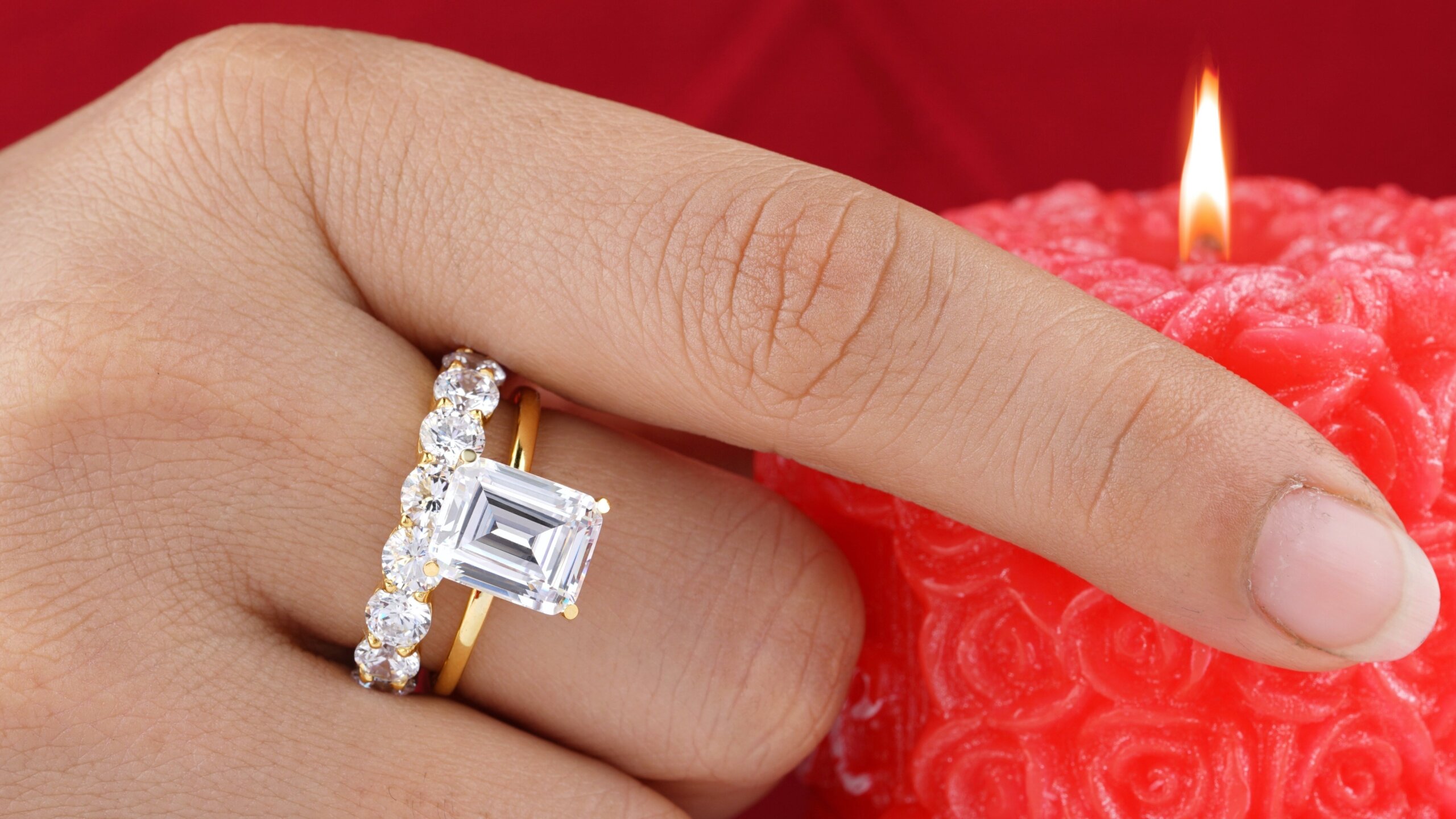
Emerald Cut vs Other Shapes
So, you’re tempted by the Emerald – and why not? It’s unique shape lives up to the natural beauty of diamond, though in an entirely different way to the other, more common engagement ring cuts. Here’s what you should know about creating an Emerald cut diamond engagement ring.
Is the Emerald Cut in Style?
It’s not the most popular cut by any means, but it’s never going out of style.
We mentioned above how the Emerald is pretty rare, and that is represents around 3% of all diamonds cut today. This is, of course, undeniable proof of the fact that the cut is nowhere near the most popular choice. If it were, then diamond cutters would be creating more and more – just as they do with the massively popular Round Brilliant, which accounts for well over half of all diamonds on the market today.
So, no, Emerald cuts are not at the height of popularity – and probably never will be since they just can’t rival the sparkle of the more popular shapes. Nevertheless, the Emerald enjoys a steady popularity. It doesn’t come in and out of style with the same unpredictability as the Pear and Heart cuts, for instance.
In other words, it’s a choice that will outlast any changing trends. Like the Little Black Dress or the Rolex, it’s always in style – and always will be.
Is the Emerald Cut Good for an Engagement Ring?
Yes, it is a beautiful and original choice for any bride to be, without being too ‘out there’.
There’s plenty of reasons to stray from the norm and embrace an Emerald cut – and one of the most compelling is the fact that this shape offers the opportunity to offer a fresh take on some of the most popular ring designs.
Take, for instance, the halo – a feature that is most commonly used on the Round Brilliant, like in this Round Halo Ring. With an Emerald, the design is totally transformed; the contrast between the deep, glassy shine of the center stone and the glitter of the halo and pavé setting in this Emerald Cut Halo creates something more unique, but still classic.
What Does an Emerald Cut Diamond Say About You?
It says you favor a simpler kind of elegance – one that emphasizes the small details – and the timeless elements of style.
It’s also strong, resilient and the perfect blend of unique and understated, making it an ideal choice for many modern brides-to-be looking for a ring to wear and pass down through the generations.
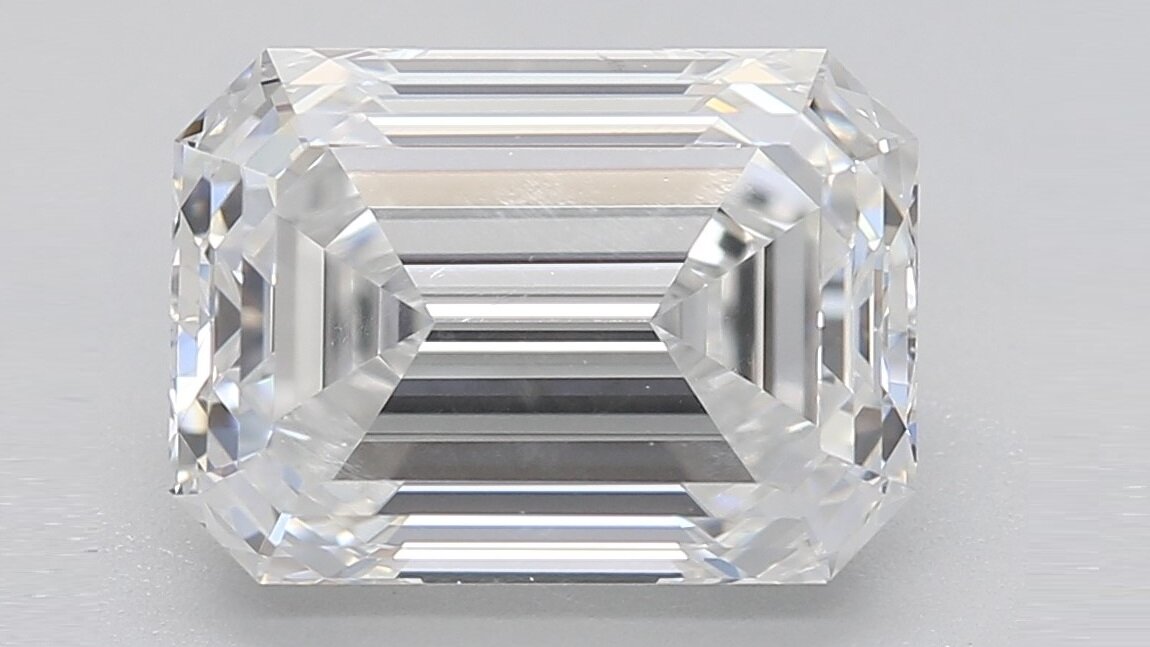
Emerald Diamond Cost and Value Considerations
Not all diamonds are created equal, and shape plays a pretty significant role in the value of a diamond. For anyone shopping for an engagement ring, it’s vital to have a good foundation of knowledge in this arena – particularly when understanding the value of certain shapes could wind up benefitting you – and your final bill.
Emerald Cut Cost vs Other Shapes
The Emerald cut is cheaper than many of the more expensive (and more sparkly) shapes, and an Emerald cut engagement ring will typically cost significantly less than an otherwise comparable Round or Princess cut engagement ring.
What do we mean by ‘otherwise comparable’? In essence, two diamonds that are similar in all respects (sharing the same grades for cut quality, clarity and color, the same level of fluorescence and the same carat weight) and only differ in shape. If this is the case, then the Emerald will considerably less expensive than many of the other shapes.
Nevertheless, there is one major caveat. We’ve already hinted a few times at the fact that the Emerald is great for showing off the clarity of a diamond. It reveals more of the internal structure of the stone than the more brilliant cuts.
What does this mean for you? It means that you’ll likely need to aim for a higher clarity grade for your chosen carat weight than you would in a diamond of the same weight, but which features a brilliant facet pattern.
Why Emerald Cuts Are Cheaper
There are two main reasons, with the most notable being that the Emerald cut is far less popular than a long list of other shapes, and particularly those that yield more fire and brilliance.
The other reason is down to economy. As with the emerald, it is possible for the diamond cutter to preserve a lot of the original rough stone in the creation of the Emerald cut – much more than they would when cutting a well-proportioned Round Brilliance, for instance.
As a result, less diamond is ‘wasted’, and the diamond cutter does not lose anywhere near as much potential profit by choosing this cut.
The Cost of a 1 Carat Emerald Diamond
You can expect the cost to start at around $1,500, and increase to around $6,000, depending on quality.
If you’re wondering why there is so much discrepancy between those two price points, then it’s worth reading up our guide to the Four Cs of diamonds. We will, however, go into the specifics of choosing a quality Emerald cut – and the grades you can expect to focus on during your search – below.
For now, however, it’s important to keep in mind that you don’t want to be aiming for the lowest price point. This is a value reserved for very low quality diamonds – a definite ‘no’ for any stone, let alone one that reveals as much as the Emerald…
Our Expert Take
Of all the diamond cuts out there, few are as powerful as the Emerald – and none are able to rival the understated beauty and appeal of this cut.
It’s easy to feel ‘warned off’ the Emerald cut by those who focus on its low-key sparkle, but don’t fall into the trap of thinking that ‘low-key’ means non-existent. Sure, the Emerald won’t erupt into countless sparks of fire the second the light hits it, but it’s still a diamond, and diamonds will always create a magnificent light performance.
Besides that, the Emerald is a highly versatile choice. It’s more than capable of creating a spectacular solitaire, like this deceptively simple Emerald Solitaire in Platinum, or something much more ornate – and with heaps more sparkle. If you’re tempted by the Emerald, make sure to check our incredibly wide range of GIA graded Emerald cut diamonds to find the one of your dreams.
10 FAQs
- Q: What Is the Ideal Length-to-Width Ratio for an Emerald Cut Diamond?
A: The ideal ratio typically ranges between 1.30 and 1.60. A ratio near 1.50 is considered classic for an emerald cut, offering a balanced and traditional rectangular shape. - Q: How Does Clarity Affect an Emerald Cut Diamond?
A: Clarity is crucial in emerald cut diamonds due to their large open facets, which can make inclusions more visible. Higher clarity grades, such as VS1 or VS2, are recommended to ensure a cleaner appearance. - Q: Are Emerald Cut Diamonds More Expensive Than Other Shapes?
A: Generally, emerald cut diamonds are less expensive than round brilliant cuts due to less demand and more efficient cutting processes that waste less raw material. - Q: Do Emerald Cut Diamonds Sparkle Less?
A: Yes, emerald cut diamonds have a different type of sparkle compared to brilliant cuts. They offer a subtler, mirror-like shine rather than a fiery brilliance. - Q: Can I Use an Emerald Cut Diamond in a Vintage-Style Ring?
A: Absolutely! Emerald cut diamonds are well-suited for vintage-style settings, as their clean lines and elegant simplicity complement antique designs beautifully. - Q: What is the Best Color Grade for an Emerald Cut Diamond?
A: Aim for a higher color grade (G-H or better) to ensure the diamond appears white and minimizes any color tints, especially since emerald cuts can highlight color more than other cuts. - Q: Is a Higher Carat Weight More Important Than Clarity in an Emerald Cut Diamond?
A: Clarity tends to be more important due to the cut’s open table. Even with a higher carat weight, a diamond with noticeable inclusions can detract from its beauty. - Q: How Should I Care for My Emerald Cut Diamond?
A: Regular cleaning with mild soap and water, along with annual check-ups from a jeweler to ensure the setting remains secure, will keep your emerald cut diamond in excellent condition. - Q: Can Emerald Cut Diamonds Look Bigger Than Other Shapes?
A: Yes, the elongated shape and large table of an emerald cut diamond can give the illusion of a larger size compared to other shapes with the same carat weight.
Explore the unique beauty of emerald cut diamonds with Jeweler AI – your personal guide to finding the perfect ring.
FOLLOW-UP GUIDE SERIES

